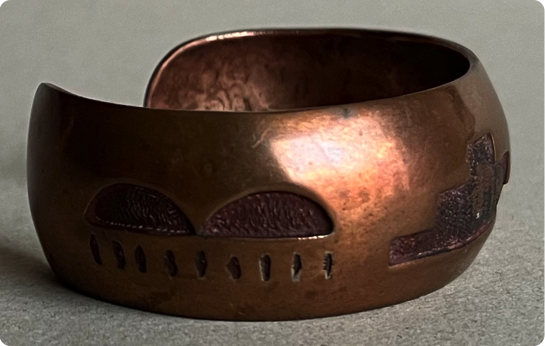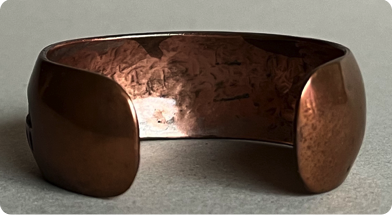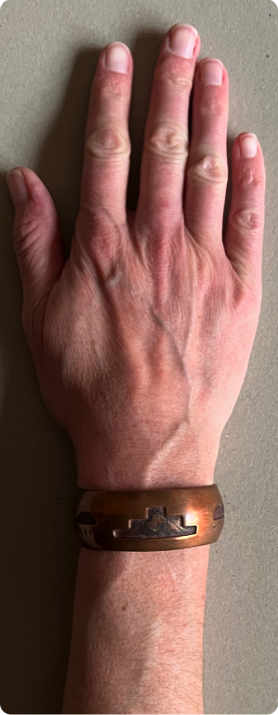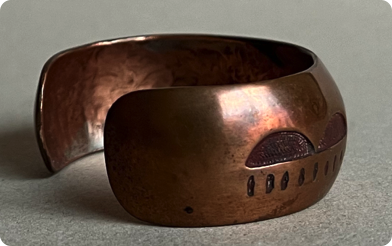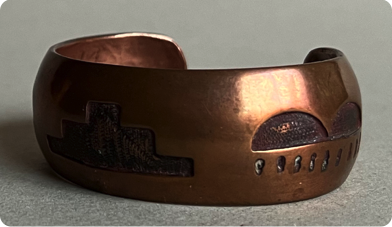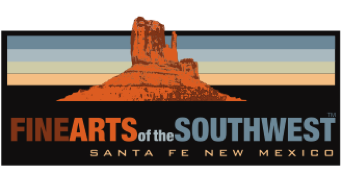
© 2010-2024 by Fine Arts of the Southwest, Inc. All rights reserved.
Unauthorized reproduction or use is strictly prohibited by law.
A beautiful and historically significant early
Hopi “overlay” style copper cuff bracelet, possibly
by Paul Saufkie, c. late 1930’s-1940’s
The creation of the unique Hopi “overlay” style of jewelry was the result of a determined official effort on the part
of the Hopi Tribe officially beginning in1946 after the second World War to establish a unique and proprietary style
of jewelry that would be immediately identifiable and distinctive as Hopi as opposed to earlier Hopi jewelry which was generally made in a Navajo style. The Hopi Silvercrafts Co-operative Guild established in 1946 by The Hopi Tribal Authority under the leadership of artist Fred Kabotie (1900-1986) and Silversmith Paul Saufkie (1898-1993) took
the lead in this effort.
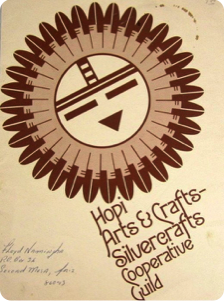
At lower left, an original promotional pamphlet for The Hopi Arts and Crafts SilverCrafts Cooperative Guild. At right, Hopi SilverCrafts Guild co-founders Fred Kabotie (left front) and Paul Saufkie (right front) with their first group of GI Bill/Hopi Guild jewelry students c. 1947-49. Each of the students is holding a placard showing his personal hallmark. Paul Saufkie at lower right front row is holding his "Snow Cloud" hallmark which resembles the central design on this bracelet.
Lower left photo source and © Worthpoint. Right photo by Milton Snow. Photo source and © Nortthern Arizona University
Unfortunately, the bracelet is not signed for the maker so we can only guess who made this fascinating piece although there is a very good chance that it is someone pictured here in this early photo above of the Hopi Silvercrafts Co-operative Guild, and we are thinking specifically here of the Guild’s talented silversmith Co-Founder, Paul Saufkie at lower right. As can be seen in this photo, each Hopi silversmith is holding up his individual hallmark and the "Snow Cloud" hallmark of Paul Saufkie is virtually identical to the central design on this bracelet, which is at least a very interesting and noteworthy coincidence if not completely conclusive. Typically, the vast majority of pre- overlay Hopi jewelry was unsigned as this piece is with the notable exception of early pieces made by two prominent Hopi silversmiths who worked for well-known Indian trading companies in Arizona, Morris Robinson and Ralph Tawangeouma.
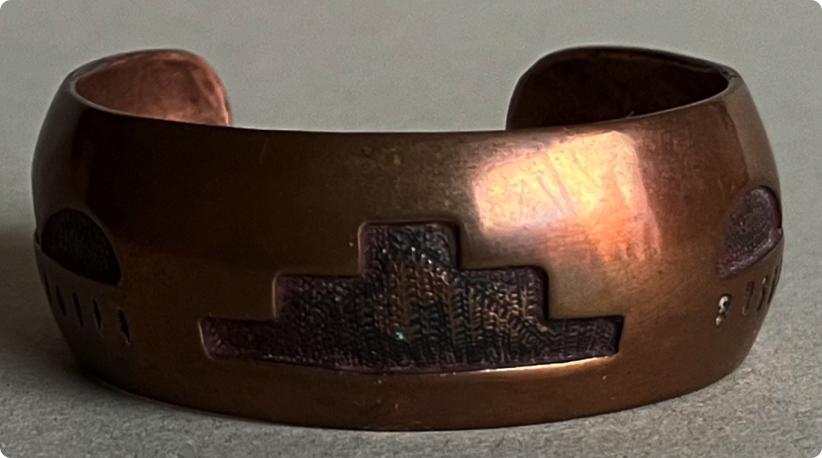
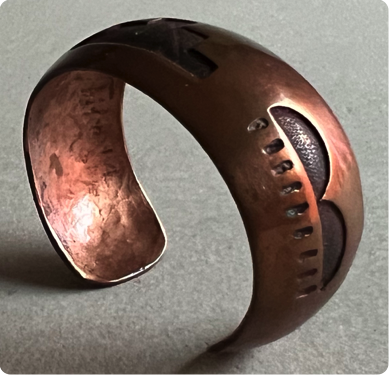
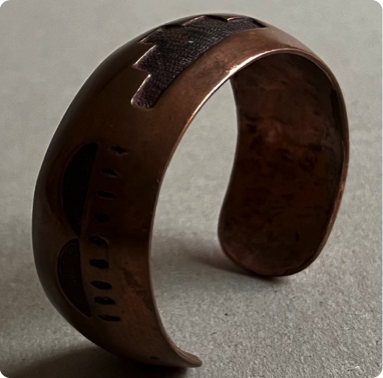
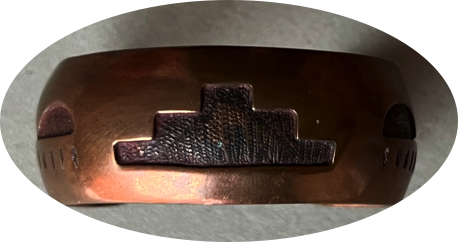
The design of this bracelet is completely and unmistakably Hopi; a spare and elegant presentation of a Hopi terraced “Snow Cloud” design flanked on either side by other representations of rain clouds and falling rain. It is striking, direct and elegant in its simplicity and sophistication and the surface contrasts between the darker grey recessed textured areas if the design against the smoother more polished upper reddish brown areas of the copper shank provide an extremely attractive visual interplay and tension.
The bracelet measures 1" in continuous width most of the way around taping very slightly down to 7/8" in width at the terminal ends. The inner circumference end-to-end is 5 1/2" and the gap between the terminals is 1" for a total interior circumference of 6 1/2". The bracelet weighs and extremely comfortable and easily wearable 42 grams or 1 1/2 ounces. The bracelet is in excellent original condition and the copper metal has developed a lovely surface patina and
coloration from age and use. As previously mentioned the bracelet is unsigned for the maker.
This is a lovely, elegant and historically significant early Hopi piece attempting to establish a distinctly
Hopi artistic jewelry identity and succeeding beautifully, simply and stylishly in our view.
SOLD
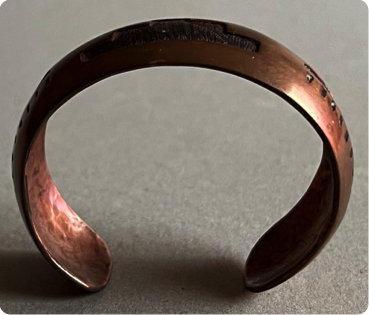
This lovely hammered copper cuff bracelet is indicative of the earliest and simplest beginnings attempting to create
and establish a distinctive Hopi overlay jewelry style. These efforts initially started somewhat informally and experimentally in the late 1930’s with the strong support of Mary Russell Ferrell-Colton, Founder of the Museum
of Northern Arizona in Flagstaff working in conjunction with Fred Kabotie, Paul Saufkie and Museum of Northern Arizona's Fine Arts Curator, Virgil Hubert.
The designs on this bracelet are rendered in a darker, recessed, oxidized and intentionally more roughly textured surface against the more polished smooth upper surface of the copper metal. However, while this particular bracelet is done in an “overlay” style and has an overlay appearance, it is not technically an overlay piece in which two layers of metal have been used, one atop the other and areas of the top layer have been removed to expose the underlying layer. In this way, we would theorize that this bracelet was a very early experimental piece attempting to arrive at the unique Hopi style, a sort of artistic prototype or experimental “Missing Link” in the evolutionary chain, if you will.

